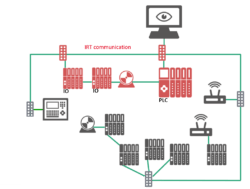Network Topology Options
PROFINET gives you flexibility for network design. PROFINET supports line, tree, ring, and star cabled topologies. In addition, it supports wireless connections via Bluetooth or WiFi(we won’t get into the subject of wireless, but you can get an overview by watching this webinar: Wireless Webinar). The section below covers the pros and cons of each topology option.
Pros and Cons
- Line: Most PROFINET devices have at least two ports, such ports are part of a built-in switch in the device. Built-in switches allow users to connect devices in a line topology without external switches.
- Advantage: Built-in switches in devices are usually available. External switches are optional. The cost reduces with less cabling and optional external switches.
- Disadvantages: If a node in the line fails, downstream nodes lose communication. Also, the user must account for line depth limitations.
- Star and Tree: Built-in or standalone switches allow for star/tree topologies.
- Advantage: If a single node fails, network operation is not fully affected.
- Disadvantages: If a central star/tree switch fails, communications to all nodes in that area will be affected. Also, these topologies require more cable and external switches with several (higher costs).
- Ring: Generally, a loop or ring on Ethernet is not allowed. PROFINET allows you to implement a ring topology by managing it with two defined media redundancy classes: Media Redundancy Protocol (MRP) and Media Redundancy for Planned Duplication (MRPD).
- Advantage: Ring topologies provide media redundancy. There are two paths for communications. In case of a failed cable or node within the ring, operations may continue.
- Disadvantages: Requires devices which support redundancy MRP and MRPD. Also, it requires additional cabling and additional configuration of the redundant nodes.
IRT Considerations
If you are planning on having PROFINET Conformance Class C components in your network and establishing Isochronous Real-Time (IRT) communications, we have good news: you can also implement all the topology options listed above. The only additional requirement is that all IRT nodes have to be interconnected on the same domain or network section. Other Real-Time or Ethernet nodes can be connected as well, but only on the edges of the domain. External switches in the IRT domain have to support IRT. The diagram below illustrates the concept.
More on Network Design
There are several other factors to consider when choosing a topology and designing an industrial network (timing requirements, physical environment, special applications, etc.) But it is beneficial to know the topology options you have together with potential advantages and pitfalls. For more information on PROFINET network design watch this webinar:
-Nelly Ayllon

